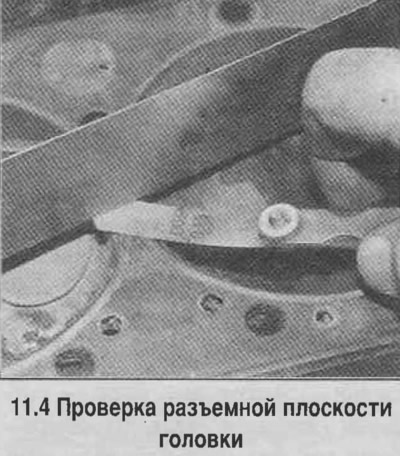2. Wash all parts of the valve mechanism with solvent, being careful not to damage them.
Head check
3. Carefully inspect the head for cracks and signs of coolant intrusion. If cracks are found, replace the head.
4. Check the deformation of the split surface of the head with a gauge and feeler gauge (see photo). If the deviation from the plane exceeds the norm, then the head should be reground.

Attention! If the head has been reground, the intake manifold flanges should also be reground.
5. Check the condition of the valve seats. In the presence of pitting (fossae), cracks, traces of burning, head repair in a car service will be required.
6. Determine the clearance between the sleeve and the valve. To do this, check the valve play in the transverse direction by shaking the valve in the sleeve and measuring the play (see photo). The valve head must be approximately 1.5 mm from the seat. If half of the total play on the indicator exceeds the norm, then the sleeve should be replaced (carried out in a car service).

Valves
7. Carefully inspect the valves, check for cracks on the chamfers of the valves, traces of uneven wear, metal carryover and burnout. Check for cracks in the necks and stems and for bending of the stems by turning the valve in the guide (see photo). Check the wear of the ends of the rods. The presence of any of these defects indicates the need for valve repair.

8. Measure the width of the edge band of each valve (from the edge of the valve head to the sealing band) and compare with standard value (see photo). If this distance is less than normal, then replace the valve.

Valve train parts
9. Measure the free length of the spring (see photo). Replace shrink springs. Before installing the springs on a repaired engine, it is necessary to check them under load on a special stand in a car service.

10. Check the verticality of the springs (see photo). If a deviation of the spring from the vertical is detected, the spring should be replaced.

11. Check the condition of the valve rotators (see photo). Replace the valve rotator if it is stuck.

Rocker arms and rocker arm drive parts
12. Check the condition of the friction surfaces of the rocker arms, the presence of cracks and wear on them.
13. Examine ends of pushers. Check up presence of deformation of pushers, having rolled them on a mirror.
14. Check up a condition of spherical axes of yokes. Pressed axle studs are changed in a car service, on parts of engines, axle studs are threaded and easily changed.
15. If the parts of the valve mechanism are in poor condition, then the cylinder head should be repaired in a car service. If the wear of the parts is within the normal range, then install them in the cylinder head, having previously cleaned it.
